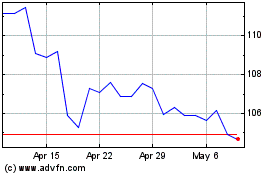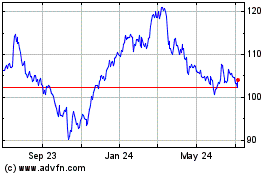Abbott Laboratories Dissolving Stent Shows Mixed Results
October 12 2015 - 4:00PM
Dow Jones News
For nearly 15 years, Abbott Laboratories has been developing a
new type of stent made of biodegradable material that gradually
disappears after restoring blood flow to the heart. The device has
been closely watched by physicians for its potential to improve on
currently available stents by reducing long-term complications of
coronary artery disease.
In a large clinical study presented Monday, Abbott's device
showed mixed results. The stent, called Absorb, performed about as
well as an already marketed stent at preventing deaths, heart
attacks and repeat stent procedures. Some 7.8% of patients who
received Absorb experienced such events, compared with 6.1% of
patients in the control group. Though the rate was numerically
higher with Absorb, the difference was small enough that the device
was shown to be statistically noninferior.
Abbott's device failed to show a significant advantage on other
measures, including a reduction in chest pain, after one year.
The study data were presented Monday at the annual Transcatheter
Cardiovascular Therapeutics conference, and published
simultaneously in the New England Journal of Medicine. Abbott
funded the study, which is intended to support U.S. regulatory
approval of the device.
Charles Simonton, vice president of Abbott's vascular division,
attributed the device's numerically higher rates of events like
heart attacks to "variability you see in any trial." Over time, he
said, Abbott expects the stent to provide significant improvement
to patients if it makes it to market, including a reduced need to
take blood thinners.
"We're going to have to prove that with long term data," Dr.
Simonton said. "But there's an intuitive element of this that many
patients and doctors already understand, and I think that's going
to drive a lot of the adoption."
The techniques used to implant the device are more challenging
than with other stents, wrote Robert A. Byrne, cardiologist at the
German Heart Centre in Munich, in an editorial accompanying the
study results in the New England Journal of Medicine. Selecting the
appropriate patients to receive the Abbott stent is also complex,
he said.
"Although the concept of self-degrading stents is intuitively
attractive, promise alone is not enough to make us unconditionally
embrace this technology," Dr. Byrne wrote.
Stents are tiny metal tubes that help prop open clogged arteries
to help restore the flow of blood to the heart, and reduce the risk
of heart attack. It is estimated that one million Americans
annually are implanted with the devices.
The world-wide market for drug-eluting stents is projected to
reach $3.82 billion in global sales this year, according to
EvaluateMedTech. About a third of global sales come from the
U.S.
Abbott's stent is made of polylactic acid, and is gradually
broken down by water contained in body tissue, said Dr. Simonton.
Patients' blood vessels gradually absorb the material, and the
stent completely disappears in about three years, he said.
Blood clotting is a rare, but serious side effect associated
with current stents. It has been hypothesized by some physicians
that the Absorb stent, by dissolving over time, could reduce the
risk of blood clotting. But in the study presented on Monday, some
1.4% of patients receiving the Absorb stent experienced blood
clotting, compared with 0.7% of patients receiving a currently
available stent. The difference wasn't statistically
significant.
The study data will make it difficult to compel many doctors to
choose Absorb, if it is approved, over current stents, which are
generally thought to be effective and safe, said Sanjay Kaul, a
cardiologist at Cedars-Sinai Medical Center in Los Angeles, who
wasn't involved in the study.
"Unless Absorb offers some tangible evidence of benefit in terms
of cost, convenience, or complications including stent thrombosis,
why would I bother putting it in my patients?" Dr. Kaul, who has
consulted for Abbott competitor Biotronik SE, said in an email.
Write to Joseph Walker at joseph.walker@wsj.com
Subscribe to WSJ: http://online.wsj.com?mod=djnwires
(END) Dow Jones Newswires
October 12, 2015 15:45 ET (19:45 GMT)
Copyright (c) 2015 Dow Jones & Company, Inc.
Abbott Laboratories (NYSE:ABT)
Historical Stock Chart
From Mar 2024 to Apr 2024

Abbott Laboratories (NYSE:ABT)
Historical Stock Chart
From Apr 2023 to Apr 2024
